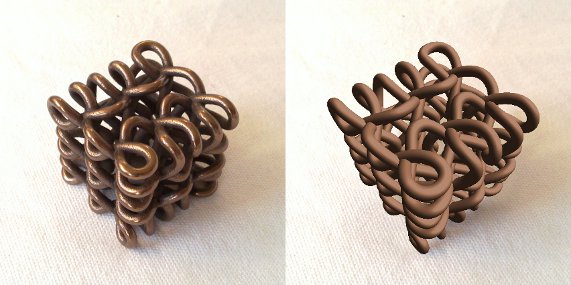List items
Items from the current list are shown below.
Blog
4 Feb 2012 : From theory to practice #
Yesterday I received another print from Shapeways. It's my first metal creation using a clever printing process that takes a 3D model as input and creates a completely formed bronze object as output.
Perhaps unsurprisingly it's another 3D Celtic knot. Once again, in spite of the dubious model I provided, the result is just brilliant. It's a real chunk of metal that looks like it's been hewn and polished into a complex shape through hours of craftsmanship. It did take hours of work of course, but in reality it was largely done using completely routine machine production techniques. Here's a shot of the result.

We all have dreams about the things we want to do when we're grown up, like becoming pop stars, train drivers, footballers or whatever. As we grow older we find we have to shed some of these hopes. There comes a point when the realisation sets in that perhaps there are people better suited to fighting dragons. Having spent practically all my life working with either maths or computers, I'd pretty much given up hope of ever doing something that actually produced physical results. It sounds like a strange dream, but the prospect of being able to create something tangible has always seemed exciting.
It's surprising then to find a path of entirely abstract ideas can lead so naturally into a process of creating physical constructs. This is the solution 3D printing offers. It allows people to turn abstract ideas into physical form, without ever having to leave the comfort of a computer screen. No need to get your hands dirty.
Of course, the physical infrastructure needed to get to this point is phenomenal (electricity, Internet, banking, etc.). Someone had to build it and huge numbers of people are still needed to maintain it. But as far as I'm concerned, sitting behind a computer screen, it's still an utterly seamless and physically effortless process. Only thought required.
You can download the 3D model for this, or buy a physical artefact, direct from the Shapeways website.
Perhaps unsurprisingly it's another 3D Celtic knot. Once again, in spite of the dubious model I provided, the result is just brilliant. It's a real chunk of metal that looks like it's been hewn and polished into a complex shape through hours of craftsmanship. It did take hours of work of course, but in reality it was largely done using completely routine machine production techniques. Here's a shot of the result.

We all have dreams about the things we want to do when we're grown up, like becoming pop stars, train drivers, footballers or whatever. As we grow older we find we have to shed some of these hopes. There comes a point when the realisation sets in that perhaps there are people better suited to fighting dragons. Having spent practically all my life working with either maths or computers, I'd pretty much given up hope of ever doing something that actually produced physical results. It sounds like a strange dream, but the prospect of being able to create something tangible has always seemed exciting.
It's surprising then to find a path of entirely abstract ideas can lead so naturally into a process of creating physical constructs. This is the solution 3D printing offers. It allows people to turn abstract ideas into physical form, without ever having to leave the comfort of a computer screen. No need to get your hands dirty.
Of course, the physical infrastructure needed to get to this point is phenomenal (electricity, Internet, banking, etc.). Someone had to build it and huge numbers of people are still needed to maintain it. But as far as I'm concerned, sitting behind a computer screen, it's still an utterly seamless and physically effortless process. Only thought required.
You can download the 3D model for this, or buy a physical artefact, direct from the Shapeways website.